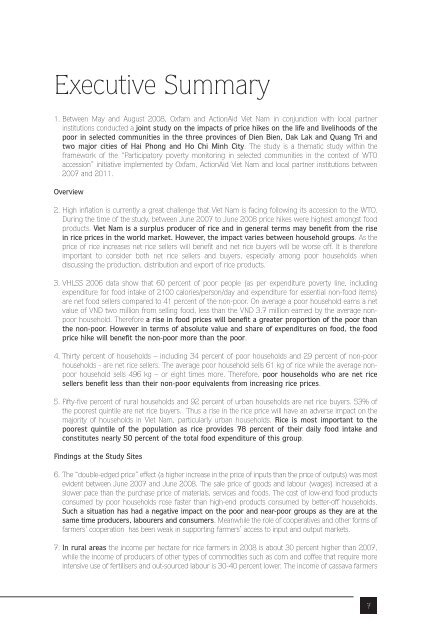Untitled - Oxfam Blogs
Untitled - Oxfam Blogs
Untitled - Oxfam Blogs
You also want an ePaper? Increase the reach of your titles
YUMPU automatically turns print PDFs into web optimized ePapers that Google loves.
Executive Summary<br />
1. Between May and August 2008, <strong>Oxfam</strong> and ActionAid Viet Nam in conjunction with local partner<br />
institutions conducted a joint study on the impacts of price hikes on the life and livelihoods of the<br />
poor in selected communities in the three provinces of Dien Bien, Dak Lak and Quang Tri and<br />
two major cities of Hai Phong and Ho Chi Minh City. The study is a thematic study within the<br />
framework of the “Participatory poverty monitoring in selected communities in the context of WTO<br />
accession” initiative implemented by <strong>Oxfam</strong>, ActionAid Viet Nam and local partner institutions between<br />
2007 and 2011.<br />
Overview<br />
2. High inflation is currently a great challenge that Viet Nam is facing following its accession to the WTO.<br />
During the time of the study, between June 2007 to June 2008 price hikes were highest amongst food<br />
products. Viet Nam is a surplus producer of rice and in general terms may benefit from the rise<br />
in rice prices in the world market. However, the impact varies between household groups. As the<br />
price of rice increases net rice sellers will benefit and net rice buyers will be worse off. It is therefore<br />
important to consider both net rice sellers and buyers, especially among poor households when<br />
discussing the production, distribution and export of rice products.<br />
3. VHLSS 2006 data show that 60 percent of poor people (as per expenditure poverty line, including<br />
expenditure for food intake of 2100 calories/person/day and expenditure for essential non-food items)<br />
are net food sellers compared to 41 percent of the non-poor. On average a poor household earns a net<br />
value of VND two million from selling food, less than the VND 3.7 million earned by the average nonpoor<br />
household. Therefore a rise in food prices will benefit a greater proportion of the poor than<br />
the non-poor. However in terms of absolute value and share of expenditures on food, the food<br />
price hike will benefit the non-poor more than the poor.<br />
4. Thirty percent of households – including 34 percent of poor households and 29 percent of non-poor<br />
households - are net rice sellers. The average poor household sells 61 kg of rice while the average nonpoor<br />
household sells 496 kg – or eight times more. Therefore, poor households who are net rice<br />
sellers benefit less than their non-poor equivalents from increasing rice prices.<br />
5. Fifty-five percent of rural households and 92 percent of urban households are net rice buyers. 53% of<br />
the poorest quintile are net rice buyers. Thus a rise in the rice price will have an adverse impact on the<br />
majority of households in Viet Nam, particularly urban households. Rice is most important to the<br />
poorest quintile of the population as rice provides 78 percent of their daily food intake and<br />
constitutes nearly 50 percent of the total food expenditure of this group.<br />
Findings at the Study Sites<br />
6. The “double-edged price” effect (a higher increase in the price of inputs than the price of outputs) was most<br />
evident between June 2007 and June 2008. The sale price of goods and labour (wages) increased at a<br />
slower pace than the purchase price of materials, services and foods. The cost of low-end food products<br />
consumed by poor households rose faster than high-end products consumed by better-off households.<br />
Such a situation has had a negative impact on the poor and near-poor groups as they are at the<br />
same time producers, labourers and consumers. Meanwhile the role of cooperatives and other forms of<br />
farmers’ cooperation has been weak in supporting farmers’ access to input and output markets.<br />
7. In rural areas the income per hectare for rice farmers in 2008 is about 30 percent higher than 2007,<br />
while the income of producers of other types of commodities such as corn and coffee that require more<br />
intensive use of fertilisers and out-sourced labour is 30-40 percent lower. The income of cassava farmers<br />
7

















